The Masonic Apron – History, Meaning, and Modern Role has long intrigued both members of the fraternity and outsiders interested in its customs. The apron is not merely an article of clothing. It is a symbol strong with the connotations of purity, work, and honor. In the lodge, it is the first thing that a new Mason receives as a gift and becomes a lifetime
Reminder of responsibility and brotherhood. For over two centuries, the apron has been a badge of recognition, a sign of labor, and an emblem of commitment. From the stonemasons’ hands of ancient times to the center of modern Freemasonry, the path of the apron weaves a tale of heritage, symbolism, and permanence.
Historical Background
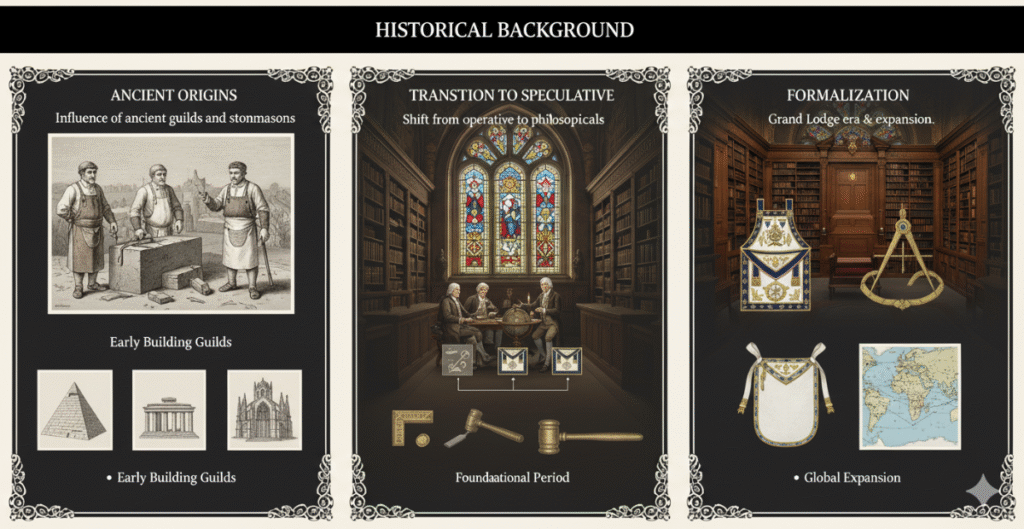
The origins of the Masonic apron stretch back to the days of operative stonemasons in the Middle Ages. Those builders wore aprons made of leather to protect their clothing while working with stone. As stonemasonry shifted from craft to a symbolic fraternity, the apron lost its practical role and gained a new meaning. It became a reminder of the connection between physical labor and moral duty.
Early Masonic records show that aprons were used in ceremonies long before they became formal regalia. By the 18th century, lodges across Europe had already established rules for wearing them. Over time, the apron grew into the most recognizable symbol of Freemasonry, bridging the old craft with new traditions of morality and brotherhood.
Symbolism of the Apron
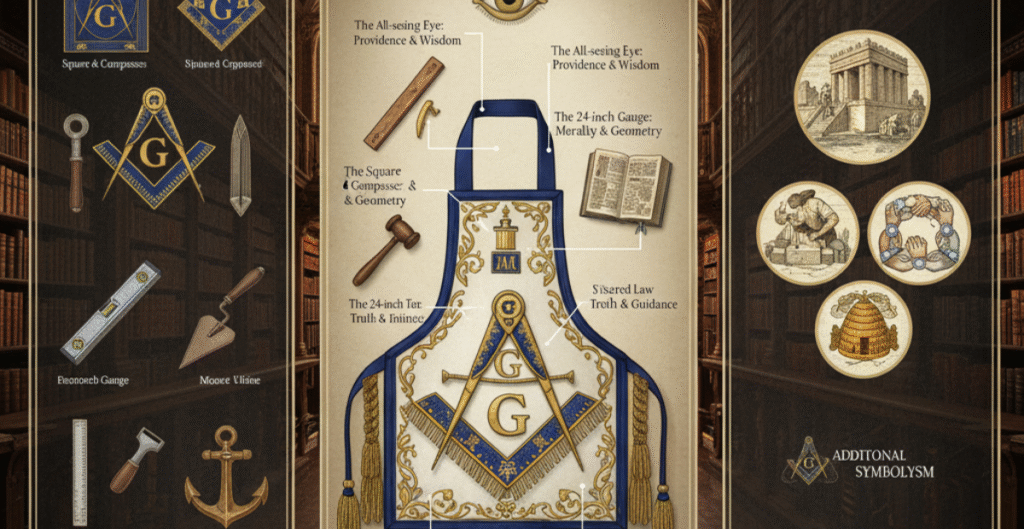
The Masonic apron is often called the badge of a Mason because it is deeply symbolic. Its white color, usually made from lambskin, stands for innocence and purity. It tells the Mason to live a clean life, free of dishonor and deceit. Every time he wears it, he is reminded of his moral obligations.
The apron also symbolizes labor and craftsmanship. Just as stonemasons built cathedrals with their hands, speculative Masons are taught to build their character and improve society. The apron is not only a reminder of past work but also a call to future action. It is both personal and universal in its message.
See more: Masonic Apron – History, Meaning, and Modern Role
Types of Masonic Aprons
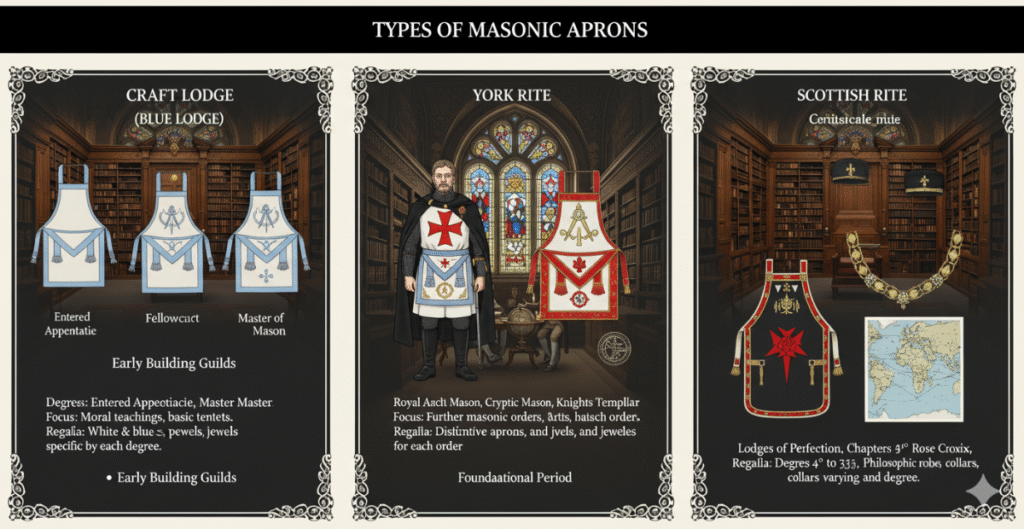
The types of Masonic aprons vary depending on the degree and the role of the Mason. The Entered Apprentice apron is plain white and simple, reflecting the beginning of a Mason’s journey. The Fellowcraft apron often has slight additions, marking the progress of knowledge. The Master Mason apron, however, carries symbolic decorations and sometimes color to represent maturity and responsibility.
Different officers and Past Masters wear aprons with additional designs, and Grand Lodge aprons are even more elaborate. Across countries, these designs may change, with American and British traditions showing noticeable differences. Despite variations, all aprons share the same foundation of meaning: honor, work, and duty.
Common Types of Masonic Aprons
| Degree/Role | Apron Style | Symbolism |
| Entered Apprentice | Plain white lambskin | Innocence and new beginnings |
| Fellowcraft | Slightly ornamented | Growth in knowledge |
| Master Mason | Decorated with symbols | Maturity and responsibility |
| Lodge Officers | Embroidered, edged designs | Authority and leadership |
| Grand Lodge Aprons | Elaborate, colorful | High honor and tradition |
Design and Materials
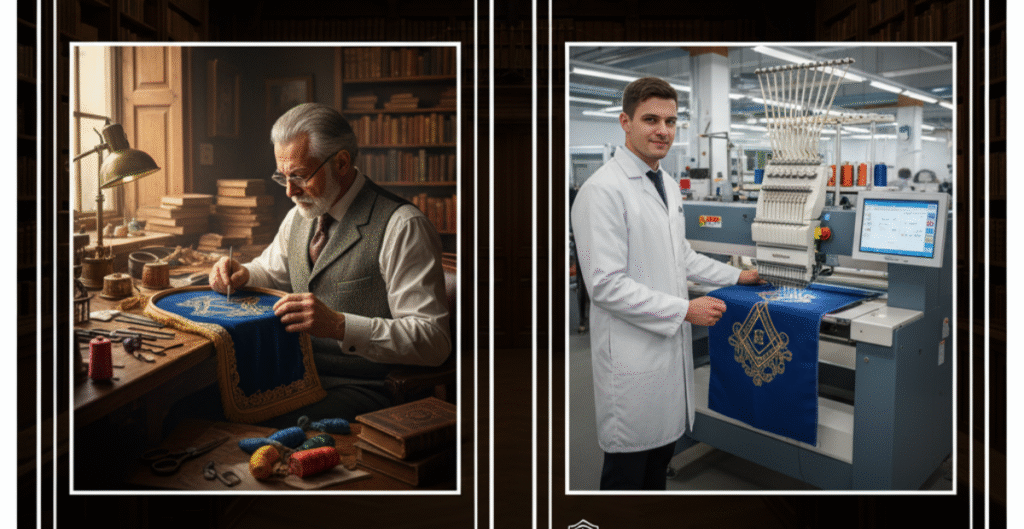
The design of Masonic aprons has always reflected both tradition and creativity. The earliest aprons were made from strong leather, fit for work. In modern times, lambskin is the preferred material because it is soft, white, and symbolic of innocence. Some aprons today may be made from cloth, silk, or synthetic material, but purists value the original lambskin.
Decoration often includes embroidery, edging in blue or gold, and symbols such as the square and compass. Regional styles differ, but craftsmanship remains central. The beauty of the apron is in its ability to blend simplicity with deep meaning.
Presentation of the Apron
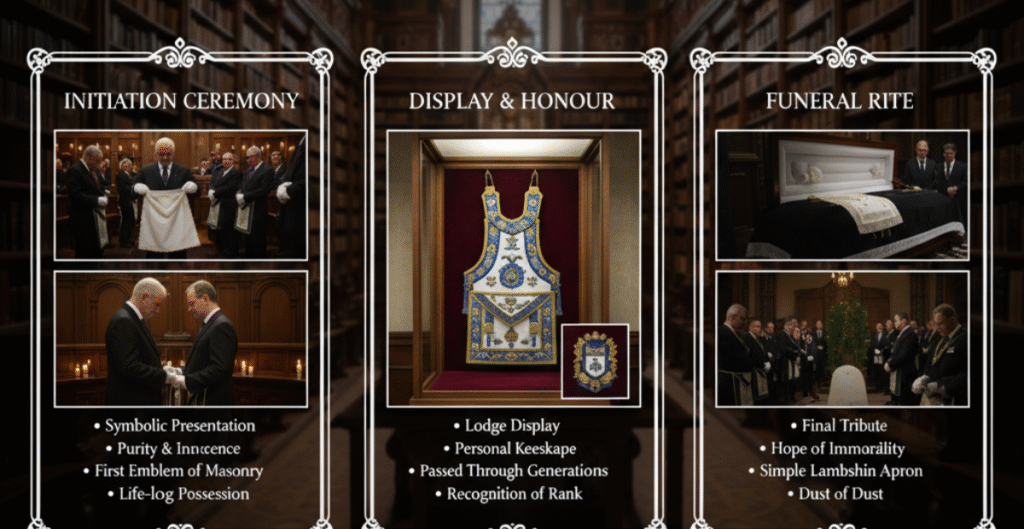
The presentation of the Masonic apron is one of the most important parts of initiation. When a candidate becomes an Entered Apprentice, he receives the apron as his first gift. It is presented with solemn words that explain its meaning and importance. This moment ties the new Mason to centuries of tradition.
The apron is then worn during lodge meetings and special ceremonies. Each time it is put on, the Mason recalls the lessons of purity, labor, and duty. The presentation is not just a formality but a ritual filled with symbolism and responsibility.
Care and Respect for the Apron

The care of a Masonic apron is guided by respect. Masons are taught to keep it clean, unspotted, and safe. It should never be thrown aside or treated as ordinary clothing. Instead, it must be stored properly, often in a case or wrapped in cloth.
Some aprons are passed down through families, carrying with them the memory of generations. Others are preserved in museums as historical treasures. This respect shows that the apron is more than fabric—it is a sacred badge of honor.
Famous References and Quotes

Throughout history, the Masonic apron has been mentioned in writings, lectures, and speeches. One of the most famous aprons is the one worn by George Washington, preserved as a national relic. It stands as proof of the apron’s symbolic power across centuries.
Many Masonic writers have described the apron as the “badge of innocence” and the “distinguishing mark of a Mason.” These words are not just poetic. They capture the essence of the apron as a lifelong reminder of virtue and service.
Notable References to Masonic Aprons
| Source/Person | Reference or Quote |
| George Washington | Wore an apron gifted by French Masons |
| William Preston | Called it “the badge of innocence” |
| Albert Pike | Wrote on its moral and spiritual meaning |
| Early Constitutions | Described aprons as essential lodge regalia |
Modern Significance
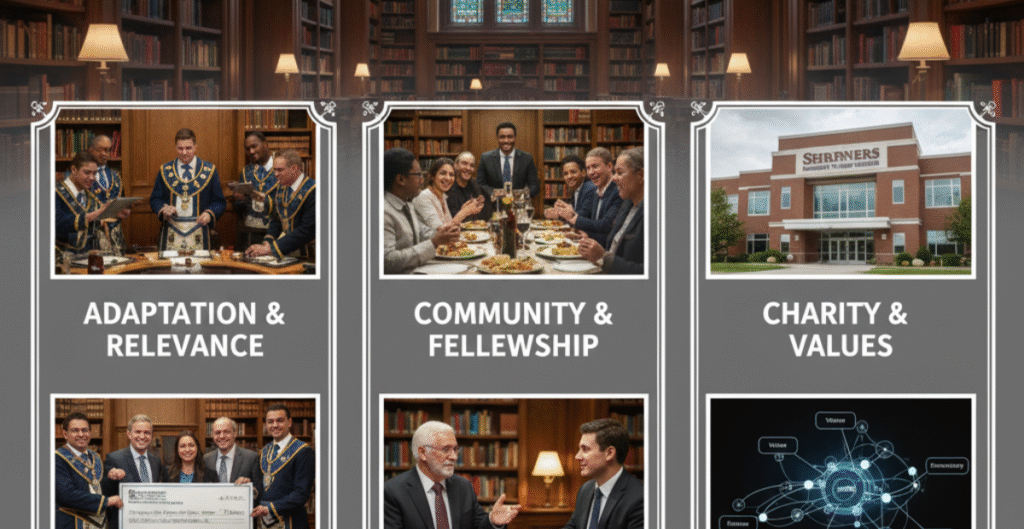
In today’s world, the Masonic apron continues to hold meaning. Even though society has changed, the apron is still worn at every meeting. It connects modern Masons with the traditions of the past. The apron is proof that some symbols never lose their power.
Beyond the lodge, aprons are displayed in museums and collected by historians. Families preserve them as heirlooms. They are also studied by scholars who see them as windows into cultural and spiritual history. The apron remains a bridge between heritage and modern identity.
Modern Roles of the Masonic Apron
| Context | Role of the Apron |
| Lodge Meetings | Symbol of membership and duty |
| Public Ceremonies | Visual emblem of Freemasonry |
| Family Heirlooms | Passed down across generations |
| Museums & Archives | Preserved as cultural and historical artifacts |
Regional Differences in Apron Traditions
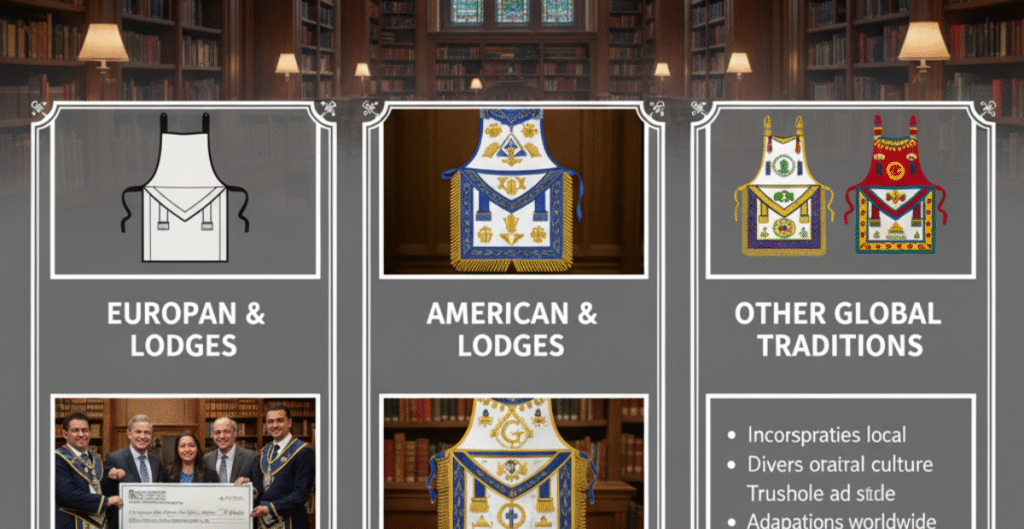
The Masonic apron is universal, but its design and use differ across regions. In the United States, aprons are often larger and decorated with blue edging. They reflect both practicality and American Masonic culture. British aprons, on the other hand, tend to be smaller and more formal, often with rosettes or ribbons to mark degrees.
In Europe, styles vary widely. French lodges favor artistic embroidery, while Scandinavian lodges prefer very simple white aprons. These differences show how Freemasonry adapts to culture while keeping the same message of purity and honor.
You will like : Masonic Regalia: History, Symbolism, and Meaning in Freemasonry
Collecting and Preserving Masonic Aprons
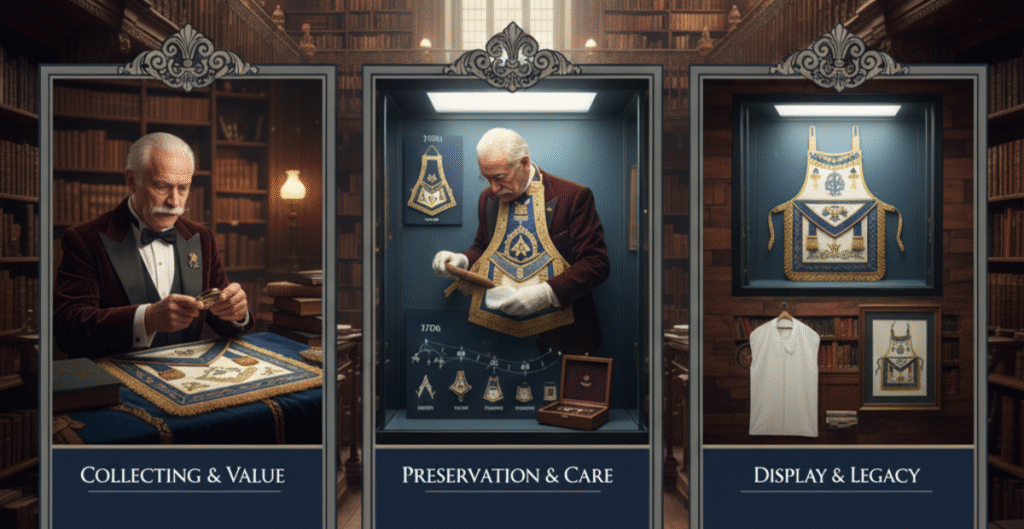
Many collectors value the Masonic apron as a piece of history. Antique aprons, some over two hundred years old, are displayed in museums and private collections. They reveal changes in design, stitching, and symbolism through the centuries. Some are even linked to famous historical figures, which makes them priceless artifacts.
Preservation is key for these aprons. They must be stored away from light, dust, and moisture. Museums often keep them in glass cases or climate-controlled rooms. Collectors follow similar care practices to protect the delicate fabric and embroidery.
The Apron in Masonic Funerals
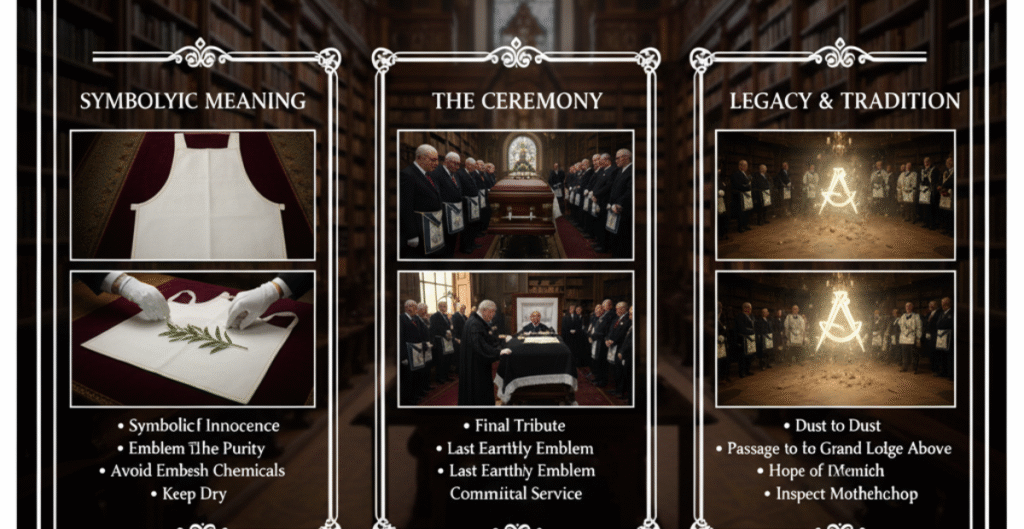
The Masonic apron also plays a role in funerals. Many Masons request to be buried wearing their apron. It is placed over the body as a final mark of their faith and commitment. This act shows that the badge of innocence remains with the Mason even in death.
Funeral services often include words about the apron, its meaning, and its reminder of immortality. This tradition links the Mason’s life on earth with his eternal journey, making the apron not just a garment but a spiritual emblem.
Faq”s
Why is the Masonic apron important?
The apron is the most visible symbol of Freemasonry. It represents purity, duty, and brotherhood.
What is a Masonic apron made of?
Traditionally, it is made of lambskin. Modern versions may use cloth, silk, or synthetic material.
Can a Mason wear another Mason’s apron?
Generally, aprons are personal. However, heirloom aprons can be passed down through family lines.
Do all Masons wear the same apron?
No. Aprons differ by degree, role, and jurisdiction. Entered Apprentices wear plain aprons, while officers and Grand Lodge members wear decorated ones.
What happens to a Mason’s apron after death?
Many Masons are buried with their apron. Others leave them as family keepsakes or donate them to museums.
Conclusion
The Masonic Apron – History, Meaning, and Modern Role is more than ceremonial clothing. It is a badge of honor, a reminder of duty, and a symbol of purity. From the days of operative masons to modern lodges, it has kept its place as the most important emblem of the craft. Every Mason who wears it carries the weight of tradition, the call to morality, and the duty of brotherhood. Its meaning will remain alive as long as Freemasonry continues to value heritage and honor.




